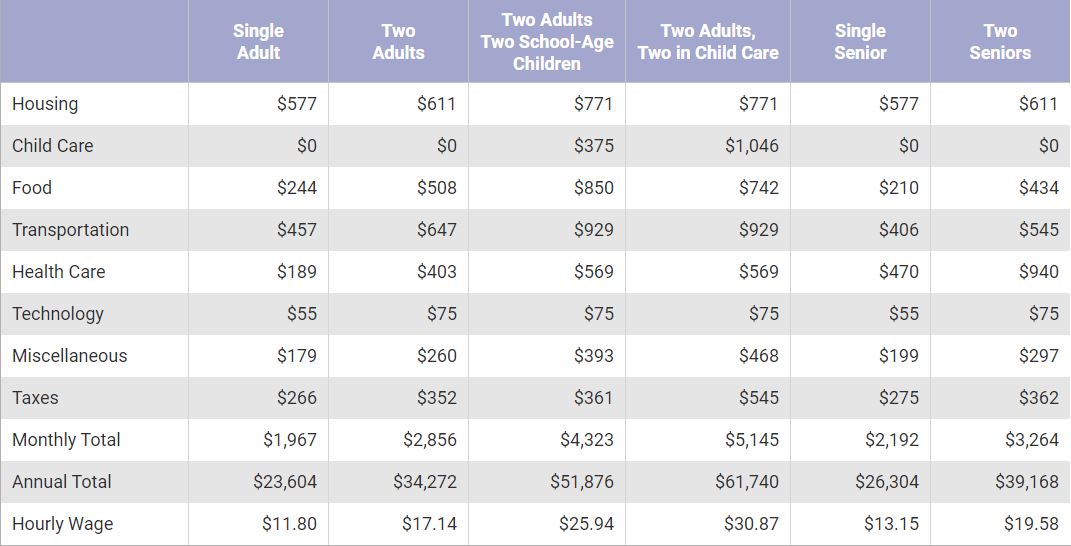Throughout West Michigan, as with the rest of the nation, there are many households who struggle to afford their basic necessities despite having one or both householders working. Although they might be above the federally-established poverty threshold, these families are still severely limited in their capacities to afford basic things like housing, child care, food, health care, technology, and transportation — presenting barriers to employment which further exacerbate the hardships endured by such households.
Families who find themselves in the situation described above are considered ALICE, which stands for Asset Limited, Income Constrained, and Employed. This term was first introduced by the United Way in 2009, working with a team in New Jersey to more accurately identify those families who were working, but still restricted in their ability to cover their expenses. Since then, nineteen states have adopted the ALICE methodology to assess their populations through data provided by the U.S. Census Bureau.
Using this data, the ALICE project is able to create Survival and Sustainable budgets for households of specific sizes and structures, and tailor those budgets to the cost of living associated with geographies as small as counties, cities, or townships. In doing this, ALICE can provide a picture of the Economic Viability of an area, including Housing Affordability, Job Opportunities, and Community Support.
ALICE Trends, Statewide
In Michigan, the newest ALICE report was released in March of 2021 with Census data captured in 2019 and portrayed that 38 percent of Michigan households earned incomes below the ALICE Threshold that year. This represents a 5 percent improvement from the proportion of households across the state who were unable to afford their basic necessities in 2017, when the bare-minimum Household Survival Budget for a family of four stood at nearly $61,272. Despite experiencing a modest inflation rate of 17 percent over the period from 2010 to 2019, Michigan’s average bare-minimum Household Survival Budget for a family of four (2 adults and 2 children in child care) has risen by 32.9 percent to stand at $64,116 in 2019. However, the United Way’s 2020 ALICE Report now includes an additional family category, which illustrates the survival level budget for a family comprised of 2 adults and 2 school-age children, which stood at $53,484 in 2019.
Of the 1,506,152 households across the state with incomes below the ALICE Threshold in 2019, just over one-third (504,237 households) also earned incomes below the Federal Poverty Level — comprising nearly 13 percent of all households across Michigan. Comparatively, 15 percent (570,417) of households met the same qualifications in 2010, when just under 40 percent of households across the state were living with incomes below the ALICE Threshold.
Who’s Struggling in West Michigan?
The ALICE project uses Census data to create Survival and Sustainable budgets for households of specific sizes and structures, tailoring those budgets to the cost of living associated with geographies as small as counties, cities, or townships. The Household Survival Budget calculated for West Michigan’s 13 counties stipulates that a single adult had to earn at least $23,604 in 2019 to afford their basic necessities. For a family of four with 2 adults and 2 school-aged children, a combined annual income of $51,876 was required to cover basic expenses in 2019. The survival budget for a family of four with two infants or toddlers in child care was substantially higher, estimated at $61,740.
ALICE Household Survival Budget, West Michigan, 2019

Michigan Association of United Ways, 2021 ALICE Report (data from 2019).
With respect to the 13-county West Michigan region, the latest ALICE Report would indicate that 36.2 percent of households earned incomes below the ALICE Threshold in 2019, an improvement of 2.6 percentage points from 2017. Of the 218,348 households across the region who fell into this category, 66,349 (11%) also earned incomes below the Federal Poverty Level. Compared against the remaining 1,519 counties participating in the ALICE project nationwide, the 13-county West Michigan region would rank 373rd with 63.8 percent of households living above the ALICE survival budget — just under the 75th percentile. Access the full report to see how your county compares: https://www.unitedforalice.org/michigan.
Future Data Topics
Have you been enjoying these “Data Points” blogs and are interested in other data? Let us know what topics you’d like to know more about on our Twitter, Facebook, or LinkedIn! We’d like to crunch some numbers that you’re interested in!
{{cta(‘be643ac7-73e2-40f6-a7b2-7c5927924bf4′,’justifycenter’)}}


